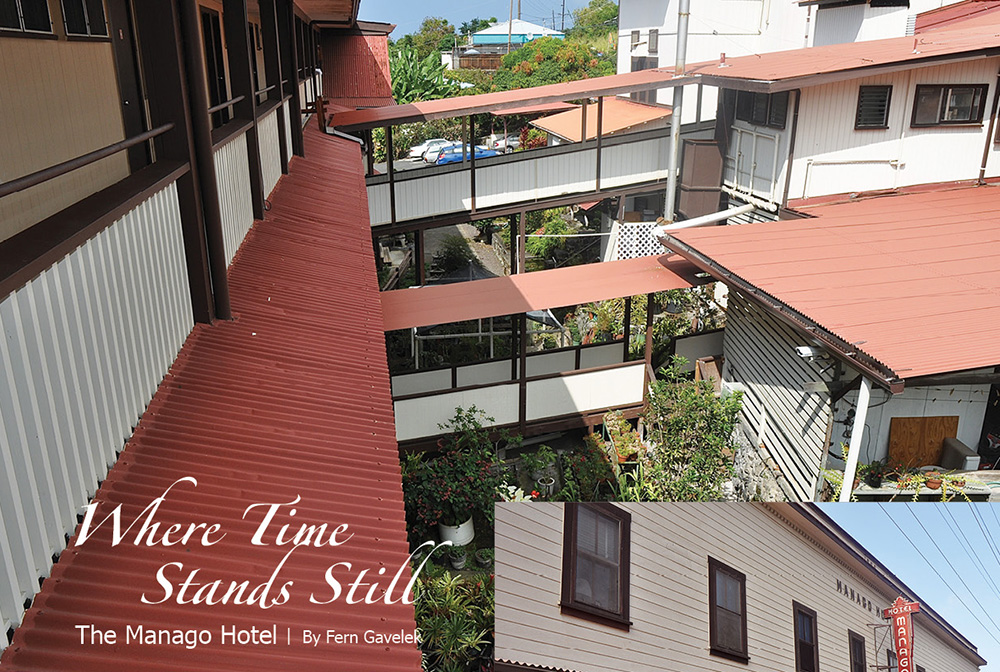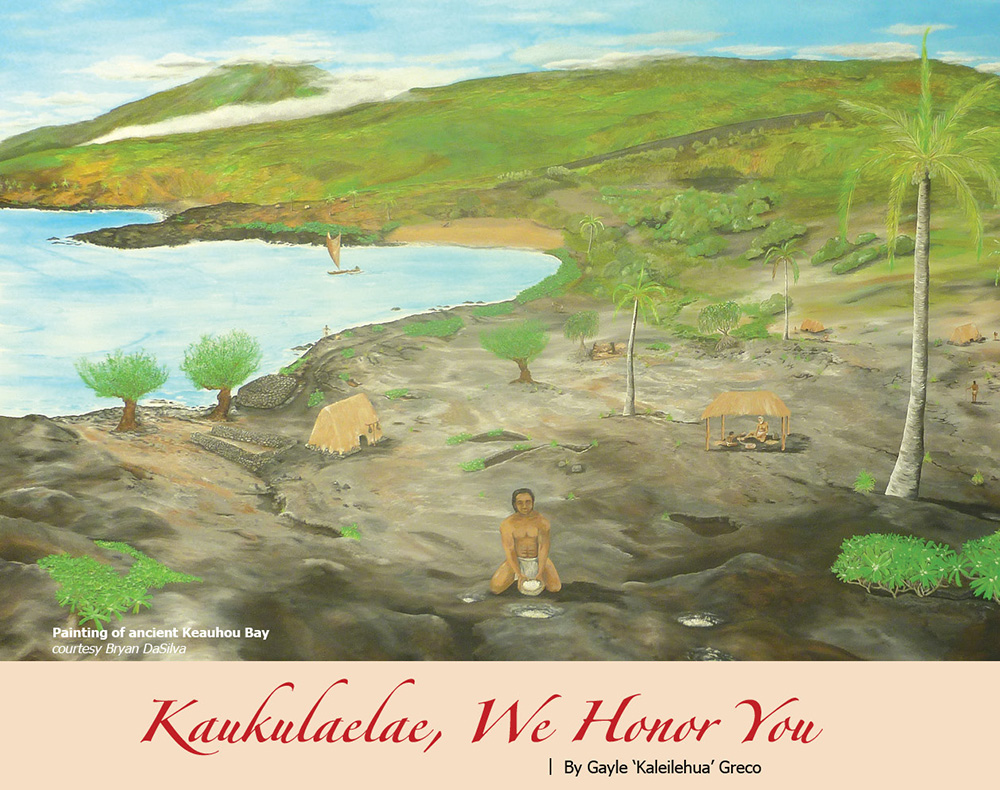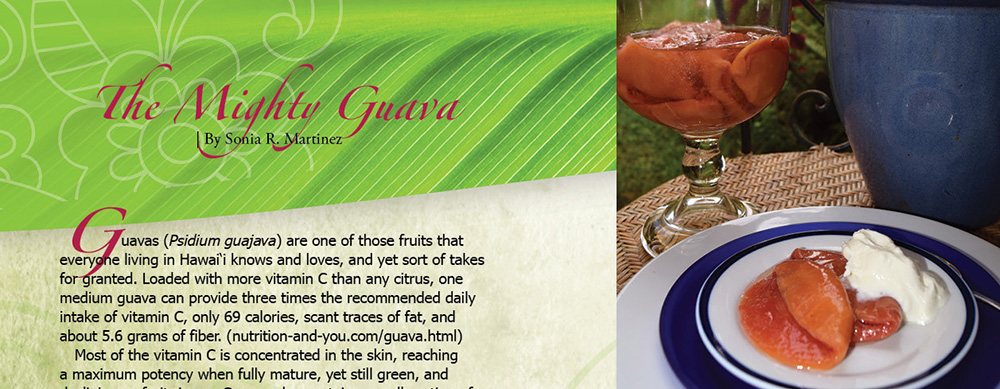
Where Time Stands Still: The Manago Hotel

By Fern Gavelek
Named after the family who founded it, the Manago Hotel endures as a piece of old Hawai‘i attracting visitors from around the world. With spotlessly clean, no-frills rooms that are accessed by a simple key, the Manago Hotel offers a step back in time.
Located in the heart of Captain Cook, the hotel sprawls along the makai (ocean) side of Highway 11 across from Arthur L. Greenwell Park. Opened in 1917 in a two-room building by the late Kinzo and Osame Manago, the hotel expanded over the years to serve the needs of the community.
Large portraits of the late founders greet guests who enter the high-ceilinged lobby, along with dark wooden counters and cabinetry. At the helm of the Manago today is the couple’s grandson, Dwight, 62, who is often seen manning the front desk.
Woven into the Manago Hotel’s history are the captivating stories of two immigrants who came to Hawai‘i from Japan. Kinzo arrived when en route to Canada to study English. However, one of his travelling companions lost Kinzo’s money gambling in Honolulu. Broke, Kinzo came to Hawai‘i Island to look up a relative and find work. He became a cook for the Wallace family in Captain Cook and saved money to send away for a picture bride.
Osame was one of 14,000-plus picture brides who immigrated to Hawai‘i between 1907–1923. She arrived in Honolulu in 1913 where the couple married at a Shinto shrine. A farmer’s daughter, Osame was a hard worker. She got jobs sorting coffee beans for the Captain Cook Coffee Mill and embroidering linens. The Wallaces encouraged the couple to open a coffee shop, loaning them $100.
The Managos bought a small building and divided it into two rooms: one for their personal use and the other for a sink, stove, and table for making udon (noodles). In addition to the udon, they baked bread to serve with jam and coffee. The couple also did laundry and made a profit of about $10 a day.
After their second child was born, Kinzo added another room, and soon taxi drivers travelling between Hilo and Kona inquired if they could spend the night. With that, the Manago Hotel was in business—charging 50 cents to $1 a night for a single bed or a futon on the floor.
In the book, Hanahana: An Oral History Anthology of Hawaii’s Working People, Osame is quoted, “I told my husband that this is a good business and that we should add a second floor to have more rooms. And we divided one room into two, with six tatami, or straw mats, in the front room. We advertised that we had a Japanese room. It became popular and everybody came.”
With more rooms for overnighters, the hotel also provided meeting space for local companies, acquired restaurant help in exchange for room and board, and expanded to offer “sake, beer, and other things.”
With money the enterprising couple saved, the Managos traveled to Japan in 1929 as Osame’s father asked to see his grandchildren. They hired help to operate the hotel and planned a three-month stay, towing their six children—aged 14 to seven months.
When gone a month, the couple received a letter saying a new hotel was being built next door and that it would take all their business away. To the dismay of Osame’s parents, the visit was shortened—and at the bidding of her only sibling—Osame left her baby to be reared by her mother.
In the book, again, Osame shared: “My sister said my mother would feel so sad when we left that Mother would go crazy or become sick. And she took my baby and carried her away into a nearby shrine…But, I realized how sad my mother was, and understood how she felt about my children. After all, I had many children; I thought I could leave one child with her. I told myself it would be okay…I was very sad, but I also thought of the time I left my mother many years ago to come to Hawai‘i. I owed her for that, and I had to pay her back.”
The Managos returned to find the competing hotel up and running, and so they got to work expanding their own. Money was borrowed from the bank and a contractor chosen. Built in 1929, the addition enlarged the hotel’s capacity to 22 rooms with shared baths and includes today’s hotel lobby and restaurant areas.
Unfortunately, the wholesale price of coffee soon dropped from 19 cents to a dime and the hotel’s business suffered. Kinzo took a day job in Nāpo‘opo‘o and did laundry at nights to make ends meet. The older children helped with the family chores and earned money picking coffee while Osame ran the hotel. Business eventually improved and then everything changed with the 1941 attack on Pearl Harbor.
“At that time, my father [Harold] was a student studying accounting and real estate at UH,” says Dwight. “The school was closed, and when my father came home, my grandfather met him outside on the sidewalk and told him he was going to run the business starting tomorrow.”
Fearing possible property confiscation and internment, Kinzo put the hotel in American-born Harold’s name. Harold and two other Manago siblings went off to war and the remaining family ran the hotel.
“Grandma [Osame] always said, ‘I’m boss until I die,’” recalls Dwight.
During the war, the Manago Hotel was closed to the public to feed the military occupying Konawaena School and accommodate troops on furlough from Honolulu. Post-war, Harold oversaw the hotel’s operation while teaching accounting at Konawaena High School.
In 1959, Dwight says the hotel added eight units with private baths to create a back wing.
“There was no county water then so we had catchment tanks under the hotel,” he details.
Starting in 1965, 34 more rooms with private baths and balconies were constructed in two additions to complete the three-story wing.
When in ninth grade, Dwight was asked by his grandmother if he would be willing to take over the hotel.
“Not knowing yet what I wanted to do, I told her I would try,” he remembers. “She was worried no one would want the job.”
Dwight earned a business management degree at UH and learned the ropes of the hotel food and beverage business at the then Kahala Hilton and Hawaiian Regent hotels in Waikīkī. In the early 1980s, he returned to Hawai‘i Island to serve as food and beverage director of the Mauna Lani Bay Hotel and Bungalows. Dwight didn’t hold the post long, as Harold wanted to retire.
“I told Dad I would come home if he would give up the reigns of the operation,” notes Dwight. “ I knew I wanted to change things and I didn’t want any type of confrontation.” Harold assured his son he was ready to retire, and true to his word, never interfered.
“Right away I wanted to put TVs in every room and add all these amenities,” shares Dwight. “But the customers told me, ‘If you change anything, we’re not coming back.’”
Dwight says he soon learned that he wasn’t the boss, and “the true boss is the customer.” He found the Manago would be successful by keeping the old Hawaiiana feel. “It is our niche,” he adds.
And so today, there are still no TVs or phones in the hotel’s 64 rooms—though there’s Wi-Fi access for guests and a TV room by the lobby. The first 22 rooms still have shared baths. Starting at $33 a night for a single, these rooms are especially popular with long-term guests and European travelers who are accustomed to sharing baths and sleeping quarters. At a 1,350-foot elevation, tropical breezes replace air conditioning and there’s free parking on both sides of the hotel.
A novelty is the private Japanese room with a traditional futon on tatami mats and furo tub in the bathroom.
“It is charming, romantic and enjoyable,” reviews Andrew of Los Angeles, California on yelp.com. The grounds also boast a Japanese garden and paths wandering among potted bromeliads, orchids, and anthuriums.
The on-site restaurant is an attraction in itself, and according to thrillist.com, the oldest continuously operating restaurant in the state. Popular for huge breakfast pancakes and the tradition of serving several mini side dishes with each lunch or dinner entrée, the family-style eatery has many repeat customers. Displayed on a chalk blackboard, the menu includes melt-in-your-mouth butterfish, ‘ōpelu, liver, teriyaki chicken, shrimp sauté and New York steak. The #1 dish is the pork chops that are prepared in a cast iron pan specifically designed years ago for the restaurant.
“We go through about 2,200 pounds of pork chops a month,” smiles Dwight.
Numerous entries on the hotel’s register best express the success of the Manago’s niche.
“Phenomenal!” writes a guest from Nome, Alaska. “Reminds me of my childhood,” scribbles a man from New York state. Another entry claims, “We’ll definitely be back!” ❖
Contact the Manago Hotel
Contact writer and photographer Fern Gavelek


